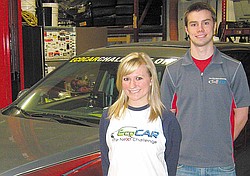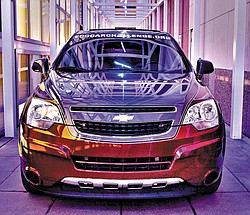OSU students from Valley work on next-generation cars
Submitted photo
Abby Underwood, a Braceville native, and Ryan Everett of Canfield are part of Ohio State University's EcoCAR: The NeXt Challange team to produce a fuel-efficient vehicle.
Submitted photo
This EcoCAR was designed by a team of 50 Ohio State University students as part of an engineering competition. General Motors and the U.S. Department of Energy sponsor the competition.
By Denise Dick
COLUMBUS
Two Mahoning Valley natives are part of a team of university students striving to create a next-generation vehicle.
Abbey Underwood, a Braceville native and a senior at Ohio State University, and Ryan Everett of Canfield, who is pursuing his master’s in mechanical engineering at OSU, are part of that school’s EcoCAR team. EcoCAR: The NeXt Challenge is a three-year collegiate student engineering competition that focuses on vehicle integration of advanced propulsion technologies.
Ohio State is one of 16 universities across the United States and Canada competing in the contest.
Students are to design vehicles that reduce emissions and minimize fuel consumption but retain performance.
The OSU team includes about 50 students.
“It’s really great,” said Underwood, a graduate of LaBrae High School. “Not all of them are business majors or engineering majors. We have nursing majors and photography majors.”
Though team leaders are typically graduate students working on the project as their thesis, other team members are volunteers who just have an interest in the automotive industry.
The U.S. Department of Energy and General Motors created the contest.
Underwood works on the business side of the project as the outreach coordinator for the team. Everett, a Canfield High School graduate, is lead developer on engine controls for the team.
For Underwood, the involvement of GM made her want to get involved.
“I grew up close to Lords- town,” she said. “My friends had family who worked at GM.”
She remembers those friends’ parents being laid off, the closing of the Delphi Automotive facility on Dana Street in Warren and the impact.
“I wanted to try to be on the other end of the automotive industry,” Underwood said. “It was such a big part of my life growing up.”
Everett got involved as an undergraduate and continued through a fellowship this year.
Teams received a GM crossover-utility vehicle from the company and re-engineered it for the contest.
“It’s a plug-in hybrid electric vehicle,” Everett said. “We can run it in all-electric mode, electric with the engine or with the engine basically moving the vehicle. We have an all-electric range of 50 miles. It can run for 50 miles without turning the engine on.”
The car uses lithium ion batteries similar to batteries in a cell phone, Underwood said. It’s a five-battery pack that would cost about $30,000.
“That’s why the [Chevrolet] Volt is expensive,” Underwood said. “The battery packs are not mass-produced yet. Of course the batteries were donated to us.”
Last weekend, the team put the vehicle on the highway around town, and everything seemed to work the way it was supposed to, Everett said.
“That was pretty rewarding,” he said.
The contest concludes in June when teams take their creations to a GM facility in Michigan where they will undergo the series of procedures the company puts vehicles through before offering them for sale to the public. That includes towing, cabin capacity, acceleration and braking tests.
Judges evaluated vehicles in each year of the competition. The first year was the design and simulation phase, and OSU’s team took first place.
Year two, GM delivered vehicles to the teams right off the assembly line and students formed their own architecture, and OSU ranked in fifth place. By the end of this school year, vehicles must be showroom ready and prepared to drive off the showroom lot.
“This year, we’re hoping to pull out the win,” Underwood said.
 43
43


